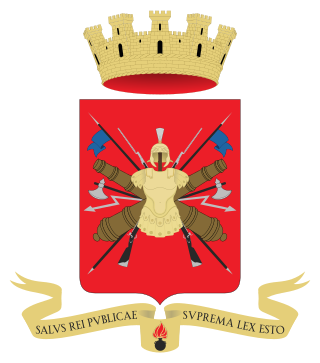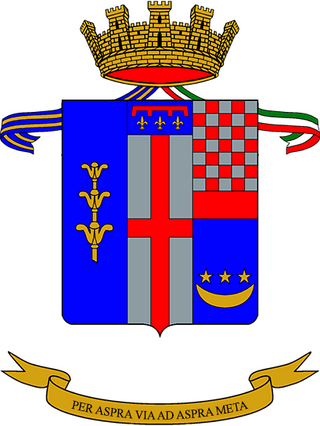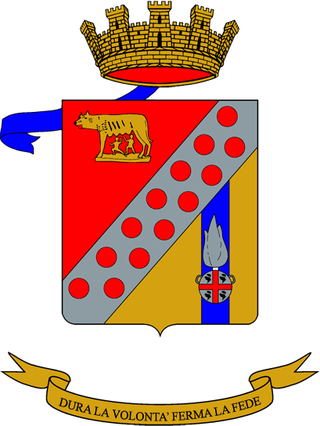
The Italian Army is the land force branch of the Italian Armed Forces. The army's history dates back to the Italian unification in the 1850s and 1860s. The army fought in colonial engagements in China, Libya, Northern Italy against the Austro-Hungarian Empire during World War I, Abyssinia before World War II and in World War II in Albania, Balkans, North Africa, the Soviet Union, and Italy itself. During the Cold War, the army prepared itself to defend against a Warsaw Pact invasion from the east. Since the end of the Cold War, the army has seen extensive peacekeeping service and combat in Afghanistan and Iraq. Its best-known combat vehicles are the Dardo infantry fighting vehicle, the Centauro tank destroyer and the Ariete tank and among its aircraft the Mangusta attack helicopter, recently deployed in UN missions. The headquarters of the Army General Staff are located in Rome opposite the Quirinal Palace, where the president of Italy resides. The army is an all-volunteer force of active-duty personnel.
The article provides an overview of the entire chain of command and organization of the Italian Army after the reform of 1 May 2024 and includes all active units as of 1 May 2024. The Armed Forces of Italy are under the command of the Italian Supreme Defense Council, presided over by the President of the Italian Republic. The Italian Army is commanded by the Chief of the Army General Staff or "Capo di Stato Maggiore dell’Esercito" in Rome.
On March 1, 1984 the Italian Institute for Disarmament, Development and Peace (Istituto di ricerche per il disarmo, lo sviluppo e la pace in Rome published the entire Italian Army order of battle down to company level – this was justified by the radical party as one of its core demands was total disarmament of Europe, even though the data which was published was top secret. The Radical Party dissolved in 1989 and the IRDISP followed suit in 1990. But Radio Radicale has survived, and the OrBat can still be found today on the homepage of the radio.

The Sassari Mechanized Brigade is a mechanized infantry brigade of the Italian Army, based on the island of Sardinia. Its core are three infantry regiments which distinguished themselves in combat during World War I. Carrying the name of the Sardinian city of Sassari the brigade's coat of arms is modeled after the city's coat of arms. The brigade is part of the Division "Acqui".

The Mechanized Brigade "Granatieri di Sardegna" is a mechanized infantry brigade of the Italian Army, based in Rome and central Italy. The brigade fields one of the oldest regiments of the Army and is one of the guard regiments of the President of Italy. The name of the unit dates back to the Kingdom of Sardinia and not the eponymous Mediterranean island of Sardinia. The brigade is part of the Division "Acqui".

After World War II the Italian Army had two units named "Centauro": from 1952 to 1986 the Armored Division "Centauro" and from 1986 to 2002 the Armored Brigade "Centauro". Both units were successor to the World War II era 131st Armored Division "Centauro". The units' name came from the mythological race of half human-half horse creatures named Centaurs.

The Motorized Brigade "Acqui" was an infantry brigade of the Italian Army, based in the centre of the Italian peninsula. The brigade's name was one of the oldest of the Italian Army and connected the brigade to its original area of recruitment around the city of Acqui. The brigade was disbanded in 1996, but re-raised as a deployable division command in 2003 and elevated to full division with assigned brigades in 2013.
The following is a hierarchical outline for the Italian Army at the end of the Cold War. It is intended to convey the connections and relationships between units and formations.

The 1st Bersaglieri Regiment is an active unit of the Italian Army based in Cosenza in the Calabria region. The regiment is part of the Italian infantry corps' Bersaglieri speciality and operationally assigned to the Bersaglieri Brigade "Garibaldi". The regiment is the most often decorated unit of the Italian Army with 14 medals for military valor. The regiment was formed in 1861 by the Royal Italian Army with preexisting battalions. During World War I the regiment's battalions served initially in Libya and then on the Italian front.
With the 1975 reforms the Italian Army abolished the regimental level and replaced it with brigades made up of multiple arms. During the reform the army disbanded 48 regimental commands and reduced its force by 87 battalions. A further ten regimental commands were used to raise ten new brigade commands. Ten training centers, which for traditional reasons had carried the names of regiments, were also disbanded. The reduction in units also allowed to mechanize most of the remaining units in Northern Italy and Italy's defense strategy changed from a hold-at-all-costs territorial defense to one of mobile warfare.

The 3rd Regiment "Granatieri di Sardegna" is a grenadiers unit of the Italian Army's infantry arm's grenadiers speciality. In 1849, the Royal Sardinian Army formed the 3rd Grenadier Guards Regiment for the second campaign of the First Italian War of Independence. The regiment was disbanded after the war's end. In 1926, the Royal Italian Army reformed the 3rd Regiment "Granatieri di Sardegna", which was assigned to the 21st Infantry Division "Granatieri di Sardegna". In 1935-36, the regiment's I Grenadiers Battalion fought in the Second Italo-Ethiopian War. In 1939, the regiment left the 21st Infantry Division "Granatieri di Sardegna" and became an autonomous unit. The same year the regiment moved from Viterbo to Tirana in occupied Albania. In 1940, the regiment was renamed 3rd Regiment "Granatieri di Sardegna e d'Albania". Between 28 October 1940 and 23 April 1941, the regiment fought in the Greco-Italian War. For its conduct in the war the regiment was awarded Italy highest military honor the Gold Medal of Military Valor. The regiment then served on occupation duty in Athens. After the announcement of the Armistice of Cassibile on 8 September 1943 the regiment was disbanded by invading German forces.

The Regiment "Lancieri di Montebello" (8th) is a cavalry unit of the Italian Army based in Rome. The regiment is the reconnaissance unit of the Mechanized Brigade "Granatieri di Sardegna" and performs public duties in Rome. The regiment was formed after the Second Italian War of Independence and participated in the Third Italian War of Independence. In World War I the regiment fought dismounted on the Italian front. After the war the regiment was disbanded. During World War II the regiment was reformed and during World War II. After the announcement of the Armistice of Cassibile by the regiment fought against invading German forces at the outskirts of Rome, which earned the regiment a Silver Medal of Military Valor. The regiment was reformed in 1951 and has served since then as one of the guard units of Rome. In 1997 the regiment became the reconnaissance unit of the Mechanized Brigade "Granatieri di Sardegna".

The 33rd Tank Regiment is an inactive tank regiment of the Italian Army, which was based in Ozzano dell'Emilia in the Emilia Romagna and last operationally assigned to the 132nd Armored Brigade "Ariete". The regiment was formed in November 1939 by the Royal Italian Army and assigned to the 133rd Armored Division "Littorio". The regiment participated in June 1940 in the Invasion of France and in April 1941 in the Invasion of Yugoslavia. In November 1941, the regiment was replaced by the 133rd Tank Infantry Regiment as the tank regiment of the 133rd Armored Division "Littorio". Afterwards the regiment trained tank and self-propelled gun units, until German forces disbanded the regiment after the Armistice of Cassibile was announced on 8 September 1943.

The 6th Pioneer Regiment is a military engineering regiment of the Italian Army based in the Cecchignola quarter of Rome. The regiment is assigned to the army's Engineer Command and the army's sole pioneer unit, whose focus, unlike the army's other engineer units, is on rear area construction tasks. In 1926, the Royal Italian Army formed the 6th Engineer Regiment in Bologna. During World War II the regiment's depot formed engineer battalions and smaller units, which deployed with divisions and corps to the fronts of the war. After the announcement of the Armistice of Cassibile on 8 September 1943 the regiment was disbanded by invading German forces.

The 231st Signal Battalion "Sempione" is signals unit of the Italian Army. The battalion was formed in 1959 and assigned to the Armored Division "Centauro". In 1975, the battalion was named for the Simplon Pass and received the number 231st, which had been used by the 231st Connections Company that had served with the 131st Armored Division "Centauro" during the Tunisian campaign of World War II. With the name and number the battalion also received its own flag. In 1991, the battalion was disbanded. In 2001, the battalion was reformed and assigned to the 1st Signal Regiment as the regiment's second signal battalion. The battalion's anniversary falls, as for all signal units, on 20 June 1918, the day the Austro-Hungarian Army began its retreat across the Piave river during the Second Battle of the Piave River.

The Transit Areas Management Regiment is a military logistics regiment of the Italian Army based in Bellinzago Novarese and Bari. The regiment is operationally assigned to the Logistic Support Command and manages the reception, staging and onward movement of equipment, personnel, and materiel from Italy to Italian military operations abroad. The regiment provides, together with the 6th General Support Logistic Regiment, third line logistic support for the army's brigades and Rapid Deployable Corps – Italy. The regiment was formed on 1 January 2015 by reorganizing and expanding the 1st Transport Regiment. The regiment's anniversary falls, as for all units of the Italian Army's Transport and Materiel Corps, on 22 May, the anniversary of the Royal Italian Army's first major use of automobiles to transport reinforcements to the Asiago plateau to counter the Austro-Hungarian Asiago Offensive in May 1916.

The Logistic Battalion "Acqui" is an inactive military logistics battalion of the Italian Army, which was assigned to the Motorized Brigade "Acqui". The battalion's anniversary falls, as for all units of the Italian Army's Transport and Materiel Corps, on 22 May, the anniversary of the Royal Italian Army's first major use of automobiles to transport reinforcements to the Asiago plateau to counter the Austro-Hungarian Asiago Offensive in May 1916.

The Logistic Battalion "Piemonte" is an inactive military logistics battalion of the Italian Army. The battalion was formed in 1976 as Logistic Battalion "Centauro" and assigned to the Armored Division "Centauro". After the division was disbanded in 1986 the battalion was reorganized as a brigade logistic battalion and renamed Logistic Battalion "Piemonte". From 1986 to 1991, the battalion was assigned to the 3rd Army Corps and earmarked to support the reserve Motorized Brigade "Piemonte". The battalion was disbanded in 1991. The battalion's anniversary falls, as for all units of the Italian Army's Transport and Materiel Corps, on 22 May, the anniversary of the Royal Italian Army's first major use of automobiles to transport reinforcements to the Asiago plateau to counter the Austro-Hungarian Asiago Offensive in May 1916.

The 13th Artillery Regiment "Granatieri di Sardegna" is an inactive field artillery regiment of the Italian Army, which was based in Civitavecchia in Lazio. Originally an artillery regiment of the Royal Italian Army, the regiment was formed in 1888 and served in World War I on the Italian front. In 1935 the regiment was assigned to the 21st Infantry Division "Granatieri di Sardegna", with which the regiment served in World War II. After the Armistice of Cassibile was announced on 8 September 1943, the division and its regiments defended Rome against invading German forces until 10 September. However the flight of the Italian King Victor Emmanuel III made further resistance senseless and after handing their weapons over to civilian resistance fighters the division surrendered to the Germans, which disbanded the division and its units on 12 September.















